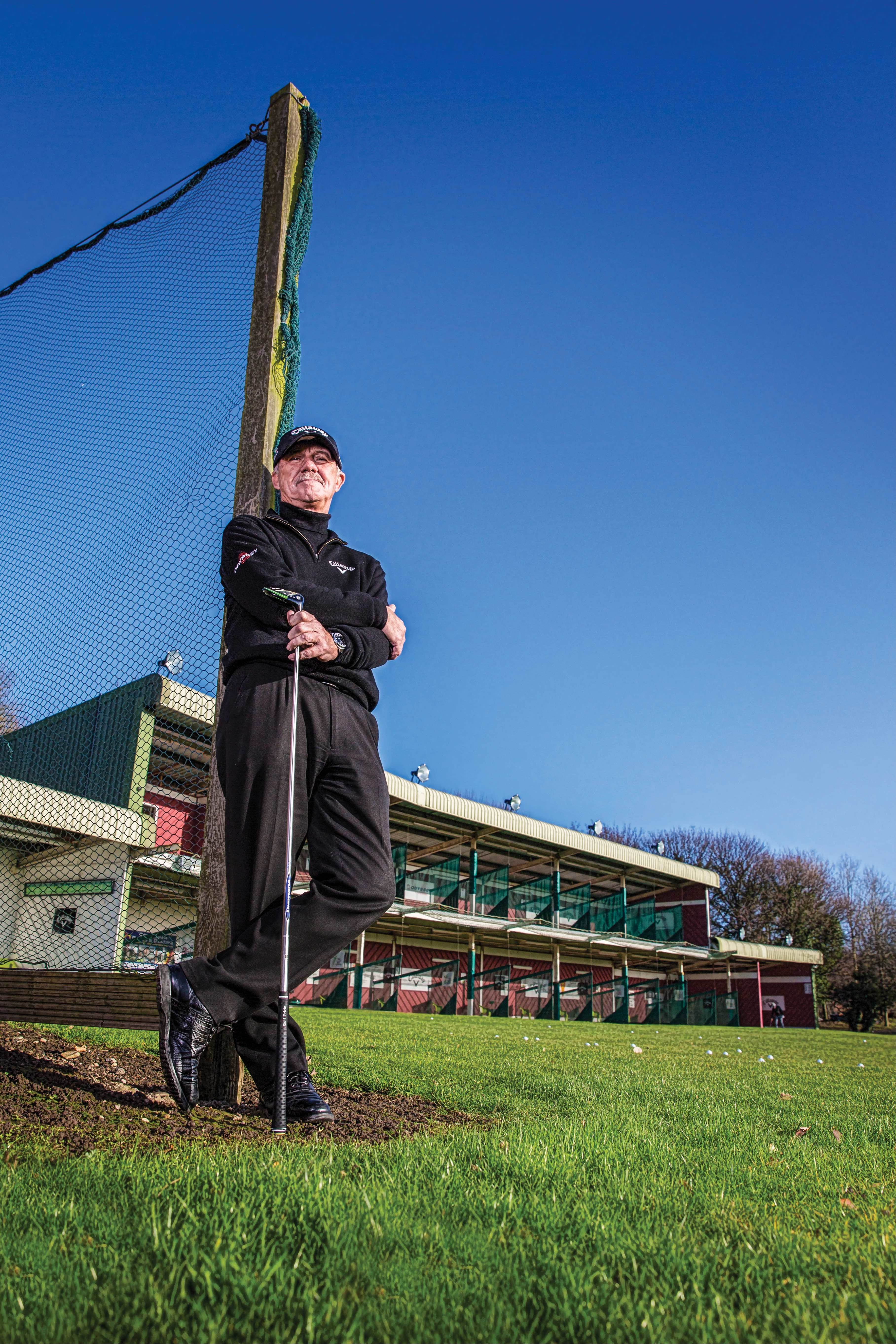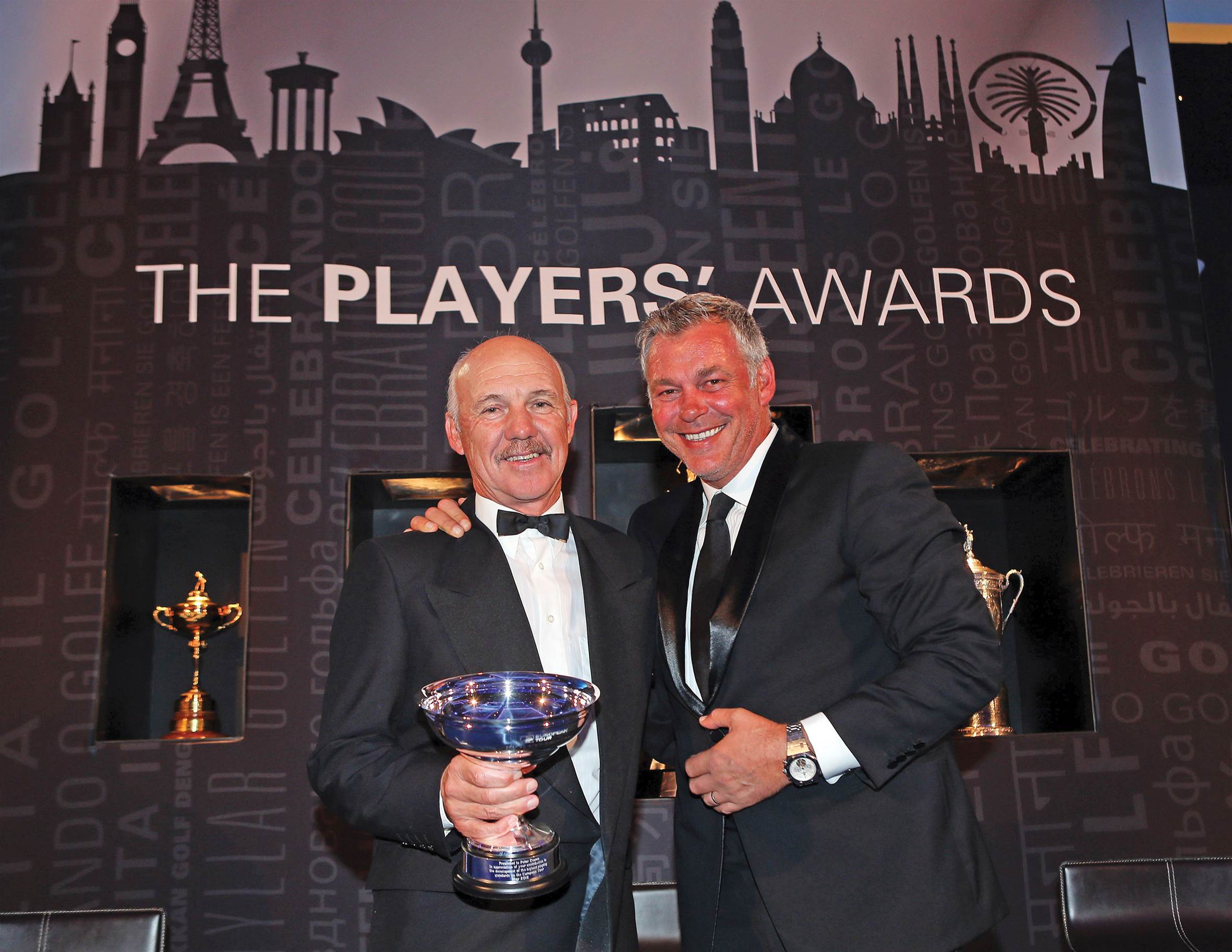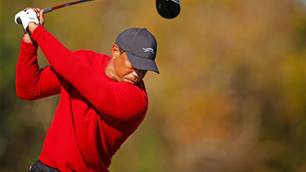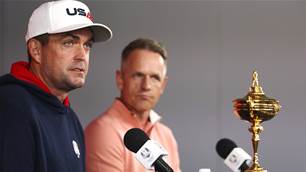John Huggan sits down with world-renowned coach Pete Cowen – whose clients have included Rory McIlroy, Henrik Stenson and Sergio Garcia – to talk everything golf.
Let’s start with the important stuff. Why do you only dress in black?
It’s easier for travel. I don’t have to think in the mornings and it looks fairly smart. Plus, in the last year I played the Tour, 1979, I had a sponsor whose company colours were black and yellow. When they went bust I was left with all this black and yellow clothing. I didn’t like the yellow.
Okay, I get that part of it. But why black? You could wear any colour now.
I could. But I’m going to wear black until they find a darker colour.
Describe yourself as a player …
I was a journeyman, a percentage player. I was that way because you had to make money every week in order to play the next week. But I failed because of my temperament more than anything else. And I wasn’t a great putter.
My last full season in 1979 I finished 56th on the Order of Merit (Bernhard Langer was 57th). And I lost money. I was 34th in the Open when Seve won at Lytham and I lost money that week, too. For a good reason. I made the cut and was drawn with Lee Elder in the final round. I couldn’t find my caddie, ‘Silly Billy’. And when I asked where he was I discovered he was in a mobile prison cell just down the road. He had been arrested for non-payment of fines. So I had to pay £200 to get him out. I won £600 that week but lost money because of that.
So what were your strengths and weaknesses as a golfer?
I only won one tournament, the 1976 Zambian Open, which was part of the European Tour back then. John Paramor’s (now chief referee) first job was to interview me. I beat Jack Newton by a shot. The year before, he had lost a playoff for the Open to Tom Watson. Jack had won the previous two weeks and was favourite to win again. I holed a 10-foot putt on the last to beat him. The first guy to congratulate me was the local bookmaker. He would have lost a fortune if Jack had won again. I won about £4,000. Johnny Miller got £6,500 for winning the Open that year so it was a pretty good week for me. And it set me on the road to buying my own flat.
But by 1979 I couldn’t make it work financially. Only the top-60 on the Order of Merit were exempt – I still think that should be the case. Now, we don’t allow youngsters to come through. Today, there are many players not on the Tour who are better than guys who are. It’s job protection, nothing more. And it won’t change. No one is going to vote themselves out of a job.
So, to sum up, I had no problem with most aspects of the game. But I was a poor putter. Although at one time I owned 26 course records. I was good over one round.
 So what held you back?
So what held you back?
I was a perfectionist. I couldn’t accept a bad shot. I was hitting 1,000 balls per day. I once snapped three clubs in one round – at a time when I had to repair my own clubs. If you think Matt Wallace gets mad now, he was nothing compared to me. He takes it out on his caddie; I took it out on myself. If I hit a bad shot, I would hit myself on the back all the way to the next shot. My putting was awful. My wife could never watch me hitting four-foot putts. She knew I was going to miss.
Where do you stand on consistency?
I think it is overrated. You can’t be consistent if you don’t hole putts every week. Jordan Spieth did it for two years. He had consistency. But he was putting great every week. Jason Day did it, too.
So it’s all down to putting?
Of course it is. That’s why I say putts should count as one-half or one-quarter of a shot. The best players would win every week. Think about it. A five-year-old child can hole a three-footer. But he or she can’t hit a 2-iron over water from 260 yards. So which one should count for more? There’s no logic to golf. And it’s not fair.
What would you do with a young Pete Cowen if he came to you now?
The reason I am reasonably successful as a coach is that I understand why I failed. All the things I tried, I know not to teach kids. After 53 years as a pro I’ve tried most things. Most of them don’t work. So I know what avenues not to go down. That’s true of temperament particularly. And you have to be a good putter.
Just good?
Look at Justin Rose. He was a poor putter. Yet at the US Open [at Pebble Beach] he averaged 24 putts per round to finish tied 3rd. He must have played very poorly for him. With those stats he would have won by 10 shots if he had hit the ball well.
I always ask players what they are trying to achieve. Most people right now are trying to produce hitters. But the guy who can make a score will always beat those guys. I know a million good hitters. I don’t know a million good players.
I’m a bit concerned that there might be only one way to play at the highest level. Do you share that feeling?
I’m not sure. Look at Brooks Koepka. He isn’t competitive every week and that isn’t because he doesn’t give a shit. So we have to delve deeper. I’m not sure he knows himself.
Why can Rory win in Canada by seven shots then be way below that level a week later? The game levels things out. And there are always going to be horses for courses. Look at Matt Fitzpatrick. He is not the biggest guy, but he has his PGA Tour card. So he can compete.
So you’re not worried that, at the very highest level of the game, golf is becoming one-dimensional?
No. Look at Nicklaus in the 1970s. People were saying the same things about him. In the 1970 Open [at St Andrews] he drove the 18th green every day. Off the same tee they use today and using persimmon woods and balata balls.
I talked with Andy North at the US Open. He reckons that Nicklaus at the top of his game, using today’s equipment, would drive the ball 400 yards.
That’s a bit of an exaggeration but he wouldn’t be far off. He certainly would have been unbelievably long. The ball has changed the game dramatically. Today’s balls are self-correcting. We used to hit balls OB regularly. If you hit one out the neck in a crosswind, it went OB. It didn’t finish in the semi-rough like it does now.
Is that a bad thing? Not for amateurs.
True. But the problem is, do you actually correct the bad swings? Or do you correct the equipment? Now, everyone on Tour drives the ball well.
Why is golf the only sport that has messed with the venues to suit the equipment, rather than the other way round?
I’m not sure. But the threat of litigation from the equipment companies must be a factor. They are powerful. And everyone calls that progress.
Is golf not supposed to be more art than science?
It’s still a bit of both. But the percentages are changing. Think of it this way. Why do spectators go to watch golf, which is essentially a boring game? Billy Foster – who caddies for Matt Fitzpatrick – told me he went out to look at the pins on the second day of the US Open. He had to walk outside the ropes and when he came back he told me he couldn’t watch the golf. It was just too slow. He stood for 10 minutes at one point just to cross a fairway. It was unwatchable.
“Golf is a niche sport. Always has been. It’s not for the masses.” – Pete Cowen
So why do people go? What are they watching? Is it the personalities? That was the case with Tiger, when he was destroying the field almost every week. You need a dominant figure. And characters. And big personalities. When I ask kids who they like to watch, they nearly always say one of the big hitters. They want to watch huge drives and big personalities. That’s what people want, more than the game itself.
There is a small percentage of geeks who are into the game.
There are loads of anoraks, but basically people go to watch people. Seve was the perfect example of that. Without Seve – or Tony Jacklin before that – European golf would have struggled.
I once played Tony in the PGA Matchplay at Dalmahoy. I beat Peter Butler in the morning, then took Tony on in the afternoon. He was a double major-champion at the time. And I beat him on the last. The sponsors were gutted.
A few years later I was playing in a big pro-am at Mere in Cheshire. Tony and I tied for the best score. So I got up and made a speech in which I said I wasn’t sure if Tony was getting better or I was getting worse (laughs). He laughed … eventually.
Newton was the same when I beat him in Zambia. All the dignitaries, including President Kaunda, were there. When I was speaking I said how nice it was to beat a schoolboy hero. Jack is the same age as me. So he shouted from the back of the room: “F*ck off you pommie bastard.” (laughs)
Let’s talk about your wife. Where did you meet?
We met at Bradway Golf Range, where I hit my 1,000 balls a day. She worked in the bar. She doesn’t like travelling and comes to Dubai maybe once a year. She hates flying. She has always been very supportive. She says she brought the kids up by herself, which is hard to argue with.
So your eyes met across a driving range?
We’ve been married 44 years. Of course, she says we’ve lasted that long because we’ve only lived together for three years (laughs). I’ve been away for the rest. The kids work at the range in Rotherham. They actually own the place now. My daughter is 41 – she doesn’t play – and the twin boys are 35. Adam is a decent player, four-handicap. Tom is more into weightlifting. My grandson is off four as well. He doesn’t listen to me much. Nick, one of my coaches at the range, works with him.
Let’s talk about Gary Woodland. What is your history with him?
He’s been very kind regarding the work we have done over the last two years on his short game. We dabbled in the long game until he came on full-time last November when Butch was retiring. It was Butch who sent him to me for the short game.
There’s more compartmentalising in coaching these days.
Yes. Because a lot of it is confidence-coaching.
Can you define that?
First, find the strengths and the weaknesses of the player. Then focus on the strengths, while working on the weaknesses – telling them why they are so good. Positive affirmation of what they are doing. Sometimes that rubs off.
So how much of your job is psychology?
A lot. It certainly was with Gary early on. He came to golf from basketball and baseball. In those games he was always told what to do. Every minute of the day. It was all planned. So now he is a golfer and his own boss. No one was telling him what to do. So it was all new. He told me he wanted me to coach him, not just teach him. I gave him structure and told him all the things he needed to do. Now he knows what to do on his weeks off, on the days leading up to an event and before competitive rounds. He didn’t before. For example, on Wednesdays to Sundays, he does warm-ups and warm-downs.
He wanted to know how to draw the ball. I asked him why. He said it was so that he could hit the tee-shot on the 16th at Augusta. Everyone else is making two and he is trying to hit his fade into the slope, starting the ball over the water. So he was always going away from the flag and if he missed the slope he was making four.
He needed a different shot. I was impressed by that attention to detail. The other shot he needed was the little knock-down, one-bounce-then-check pitch. That was tough for him with all the downcock he had. And he wanted me to talk to him as simply as possible. No technical stuff.
Every coach has had some failures. I suspect you have, too. Who immediately comes to mind?
I’ve had a few relative failures. There was one kid who was the best 13-year-old I’ve ever seen. Technically, he was as good as anyone. And he hit the ball as well as anyone. But he grew a foot in a year. And lost it all – balance and movement. It was all gone and he never got it back.
Is that a failure on my part? Possibly. I was so disappointed. I should have been able to cope with it as a coach. It was early in my career and I didn’t manage it as well as I could have. I could deal with it now.
When pros leave, what is the reason?
Lack of understanding, or interpretation. Guys come and go. Lee Westwood and Darren Clarke did back in the late 1990s. With Monty, they were the best players in Europe. Darren is probably the most naturally talented player I’ve ever taught. Brilliant. But he got in his own way. He couldn’t cope with slight imperfections. He was like me. It had to be perfect. It was stunning. And he didn’t putt as well as he might have done. It was ridiculous what happened at St George’s the week Darren won the Open. On the Tuesday, he was going home. The more I think about that, the more ridiculous it gets.
Lee and Darren came and went. Then they came back. It’s the nature of the beast. I’ve told players I’m not working for them so go elsewhere. I did that with Danny Willett. He lost all confidence in himself.

Was the 2016 Ryder Cup and the nonsense with his brother the reason?
Yes. The day that happened was the day the switch flipped for Danny. Before that, he was bomb-proof. He had everything. When we got on the plane to Hazeltine he was buzzing. He had been told he was playing five times and that he would partner Lee Westwood. He couldn’t wait to get started.
In the first practice round he didn’t play great, but that had more to do with coming straight off the plane. The next day he was fine. Then it happened. The shit hit the fan and he spent the next day defending himself. Then Darren told him he wasn’t playing on the first morning. He was gone after that. All the trouble he has had since can be traced to that incident. He’s playing better now, which is good to see. I like Danny. He was the first to ring me after Woodland won the US Open.
What do you see in Tiger’s future?
He’s swung really well for the last 18 months. He isn’t putting as much stress on his back. How he does going forward is down to how fit he is. And how much he wants to compete.
Is Tiger the best player you have ever seen? Or has he played the best golf you’ve ever seen?
He’s played the best golf.
What set him apart?
Physicality. A lot of it. Desire. I would put him down as a player who ‘needed’ to be great. Millions want to be great. But few need to be. Tiger needed to be.
Who else is in that category?
Player. Hogan. Trevino. They all had that ‘need’.
Do you have anything in your life other than golf?
No. That’s a problem. I don’t have a hobby. I used to go to football. But I can’t watch it now. It’s like playing chess on a piece of grass. The only guys I want to watch are Ronaldo and Messi. I want to see what they can do. The rest are all the same.
What was your team?
Sheffield Wednesday. They’re crap. Horrendous. The last time I went was 18 months ago, though.
Are you worried you don’t have an outlet?
If I gave up coaching, what would I do? I don’t play. I still hit balls. I sometimes listen to the lads coaching. So what would I do? I’ve had enough of travelling. Time changes kill me and I do between 200,000 and 250,000 air miles a year. I have a million miles with Virgin and BA and half a million with Emirates. I can’t use them. There are too many restrictions. Cars don’t excite me. I wouldn’t watch Formula 1 if they paid me. I watch a bit of cricket, occasionally. And I’m not a gardener. I’m scared of retirement, really.
You go business class, I hope.
Not all the time. I’m too much of a realist. If it’s £8,000 for a seat just over there and £600 for a seat here, I’m going with the £600. I don’t sleep on a flatbed when I have a flatbed so what’s the point?
How do you see the future of the European Tour?
There are a lot of difficulties. Take the British Masters, where Tommy Fleetwood did a great job as host this year. Hardly anyone from the Ryder Cup team showed up. The camaraderie we were told about didn’t make much difference. Where were Tommy’s mates? I had no players in the British Masters but I had 11 in the US PGA the following week. The fields have been tumbleweeds from the Middle East to just before the Open. No one will travel from the States. They want to play maybe 25 events, make $3-4m and sit at home.
That’s just human nature, right?
In a way. But the players who separate themselves want more. Brooks plays all over the world and he did it before he broke through. He was prepared to do the hard yards. If you want to make the Tour more interesting, make only the top-60 exempt. The rest should fight it out. That’s the way to create more good players.
I’d also have a World Tour. That’s what the public wants. It would be dominated by the PGA Tour though, so it would be about making money. No-one I can see is ‘growing the game’ right now. Not the R&A, not the USGA, not the English Golf Union. All they are doing is helping the people already within the game. They’re not looking outside that. I sympathise, though. Golf takes too long. I’d build three loops of six holes on new courses. The 18-hole model doesn’t work anymore. You can play six holes in 90 minutes after work. All the loops would be full, rather than a golf course half-empty. The only growth area is Topgolf. Non-golfers can enjoy that.
So what’s the solution?
There isn’t one. Golf is a niche sport. It’s not for the masses. But everyone needs to realise that. Kids are not going to play golf in great numbers in our weather when they can play it on the computer. We’ve also missed two or three generations because the parents have stopped playing. And there are no caddies anymore. That’s how I got started – to pay for my football boots.
When you look at a golfer, how do you rate them? It can’t be just the swing.
My first test is to look them in the eye and see if there is anything there. I could tell with Graeme McDowell right away. He’d had a decent career before 2010 when he won the US Open. But I looked him in the eye after he shot a good score in the first round that week. He’d played well and maybe should have scored lower than he did. But he wasn’t fazed. “I’ve got a big one in me, you know,” he said.
"Millions want to be great. But few need to be. Tiger needed to be." – Pete Cowen
Koepka is the same. It’s more about how they are as people than as golfers. There are millions who can hit the ball well and there are plenty I look at on the range and wonder how they earn as much as they do. There’s something there you can’t see.
You visited Gardner Dickinson – a Hogan protégé – many years ago. How did it go?
I was a Hogan man. I asked Dickinson if he could arrange for me to watch Hogan hit balls. This was 1978, so Hogan would have been about 66 and still hitting decent shots. I didn’t go, though. Dickinson told me he could ring up and ask and Ben might agree. But then I could get there and he would change his mind. You could never predict his mood. So Dickinson suggested I stay and watch Jack Grout teaching Jack Nicklaus for two weeks. I was in Palm Beach at the time, so I did. But I still wish I’d been to see Hogan.
Was there ever a Hogan secret?
His body action. He had a better engine than anyone else. He was perfect. Dickinson did tell me that Hogan did more ‘dry drills’ than anyone. In other words, he made swings without hitting a ball. I understand that now. You cannot get better just by hitting balls. It’s impossible.
Let’s say you hit 400 balls and play a round of golf every day. When you are on the course, every swing takes about 1.5 seconds. Your 40 full shots take one minute. How many great shots did you hit? Maybe six. That’s nine seconds of good work.
You now go and hit 400 balls, which takes four hours. The 400 multiplied by 1.5 seconds is 600 seconds, or 10 minutes. You’ve done a day’s work and in that day you have spent 11 minutes on physical movement to try and improve that physical movement. You’ve also done more poor movements than good ones. You’ve actually got worse, in theory. So the whole thing has been counterproductive. But everyone does that. You cannot get better just by hitting balls. It is physically impossible. How are you going to do it? Hogan’s dry drills.
What are the main coaching challenges?
Think about this. Just about every one of us comes to golf having played a moving ball game. It is hand-eye coordination and instinct. Now the ball is sitting there, not moving and you have to hit it. But it’s not instinctive any more. That’s why people end up learning all the wrong movements. Golf is not complicated. There are only three things you have to get right. You have to start the ball on the correct line with the correct flight and the correct spin. When you can do that, go and chip-and-putt. There isn’t anything else.
Who has been your best pupil?
Probably Ian Garbutt, although Thomas Pieters is close. He was the first player who ever did everything I asked of him. As a kid, he won everything. He didn’t win on Tour, but swung like ‘Iron Byron’. If he’d putted better he’d have won lots of events.
What has been holding Thomas back?
His temperament. And I think I may be part of his problem. I’ve allowed him too much rope. I’ve allowed him to be the perfectionist that I was. So he has to sort that out. He’s getting there. He’ll be alright.

What about your most difficult pupil?
The most difficult – and the most complicated – has been Henrik Stenson. But also the most satisfying. I’ve made the biggest difference with Henrik, although Lee comes close.
How bad was Henrik when he came to you?
Horrendous. He had something but he couldn’t hit a wide range with a 5-iron. He could hit two consecutive drives 400 yards apart. How he got that bad is a question I’ve asked myself. He had won the year before. His swing was such that he could miss the ball either way. So it was technical. And the bad got worse and worse. Eventually, he couldn’t get the club back.
I told him we had to take out one side of the course. Eliminating one bad shot is not too hard for a good player. But I doubted he could get all the way back. Two years in I felt that way. And I was on commission.
I think I got £40 out of him in that time (laughs). He couldn’t afford me, really.
To be fair, I only teach people I like. If I like someone I will help them. Sometimes for nothing. If I put ‘£500 per hour’ up on the wall at my range I wouldn’t get many customers. I’d get laughed at. So I’d rather do it for nothing or not much.
So how do you get paid by Tour players?
I get a percentage, which is how I would like all coaches to get paid. When I took on Lee and Darren I said to Chubby – their manager at the time – that I would only charge them if they finished in the top 10. If they did, I would get five percent. I paid all my own expenses.
It was a bit of a punt on my behalf. They hadn’t been successful yet, but I thought I could make it work. I was right. In the next five years, Lee won 25 times and Darren won about a dozen. So I did well and I got plenty of other clients. It got to the point where Chubby asked me to reduce my fees. I reduced it to four percent, but made it four percent of everything they won. That was a bad decision. In the first year I lost £75,000.
I still pay all my expenses. I don’t want players saying they pay me to come. I’m really a consultant. That would be my advice to any young coach. If you think you are any good, test yourself. Do what I did. No retainer. No guarantees. Start your own business and believe in yourself.
Finally, what is the biggest misconception punters have about the golf swing?
That it is difficult. It’s not. It’s martial arts. It’s a movement that can be improved. If we had all been taught properly, no-one would be thinking it is hard. If a young girl can do a forward somersault and land on a four-inch wide beam, the movement we are all making is not that hard. The challenge is getting rid of that misconception. If people stopped trying to ‘hit’ the ball and focused on making the right movement, they would produce better shots.
Related Articles

McIlroy pipped by Ryder Cup pal for World Tour title

Cleary: Tiger can heal and play and win again. You want to tell him he can't?












